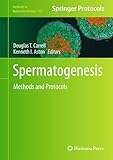Spermatogenesis [electronic resource] : Methods and Protocols / edited by Douglas T. Carrell, Kenneth I. Aston.
Series: Methods in Molecular Biology, Methods and Protocols ; 927Publisher: Totowa, NJ : Humana Press : Imprint: Humana Press, 2013Description: XVII, 554 p. 110 illus., 68 illus. in color. online resourceContent type:- text
- computer
- online resource
- 9781627030380
- 571.6 23
- QH573-671
 eBooks
eBooks
Methods For Sperm Concentration Determination -- Methods of Sperm Vitality Assessment -- The Hypo-osmotic Swelling Test for Evaluation of Sperm Membrane Integrity -- Sperm Morphology Classification: A Rational Method For Schemes Adopted By The World Health Organization -- Sperm Morphology Assessment Using Strict (Tygerberg) Criteria -- Methods For Direct And Indirect Antisperm Antibody Testing -- Manual Methods For Sperm Motility Assessment -- Computer-Aided Sperm Analysis (CASA) Of Sperm Motility And Hyperactivation -- The Hemizona Assay For Assessment Of Sperm Function -- The Sperm Penetration Assay for the Assessment of Fertilization Capacity -- Methods For The Assessment Of Sperm Capacitation And Acrosome Reaction Excluding The Sperm Penetration Assay -- Sperm DNA Fragmentation Analysis Using the TUNEL Assay -- Sperm DNA Damage Measured by Comet Assay -- Sperm Chromatin Structure Assay (SCSA®) -- Sperm Aneuploidy Testing Using Fluorescence In Situ Hybridization (FISH) -- Flow Cytometric Methods For Sperm Assessment -- Human Y Chromosome Microdeletion Analysis By PCR Multiplex Protocols Identifying Only Clinically Relevant AZF Microdeletions -- Sperm Cryopreservation Methods -- Density Gradient Separation Of Sperm For Artificial Insemination -- Recovery, Isolation, Identification and Preparation of Spermatozoa from Human Testis -- Enhancement of Sperm Motility Using Pentoxifylline and Platelet-Activating Factor -- Intracytoplasmic Morphology Selected Sperm Injection -- Sperm Selection For ICSI Using Annexin V -- Sperm Selection for ICSI Using the Hyaluronic Acid Binding Assay -- Sperm Selection Based On Electrostatic Charge -- Sex-Sorting Sperm Using Flow Cytometry/Cell Sorting -- Assessment of Spermatogenesis Through Staging of Seminiferous Tubules -- Immunohistochemical Approaches for the Study of Spermatogenesis -- Ultrastructural Analysis of Testicular Tissue and Semen by Transmission and Scanning Electron Microscopy -- Assessment Of Oxidative Stress In Sperm And Semen -- Improved Chemiluminescence Assay for Measuring Antioxidant Capacity of Seminal Plasma -- Methods of Sperm DNA Extraction for Genetic and Epigenetic Studies -- Isolating mRNA and Small Noncoding RNAs From Human Sperm -- A Review Of Genome-Wide Approaches To Study The Genetic Basis For Spermatogenic Defects -- Methods For The Analysis Of The Sperm Proteome -- Methodology of Aniline Blue Staining Of Chromatin and the Assessment of the Associated Nuclear and Cytoplasmic Attributes in Human Sperm -- Isolation of Sperm Nuclei and Nuclear Matrices from the Mouse, and Other Rodents -- Extraction and Analysis of Human Sperm Protamine 1 / Protamine 2 Ratio Using Acid Gel Electrophoresis -- Analysis of Gene-Specific and Genome-Wide Sperm DNA Methylation -- Evaluating the Localization and DNA Binding Complexity of Histones in Mature Sperm -- In Vitro Spermatogenesis Using An Organ Culture Technique -- Testicular Tissue Grafting and Male Germ Cell Transplantation -- Transgenic Modification of Spermatogonial Stem Cells Using Lentiviral Vectors -- Methods for Sperm-Mediated Gene Transfer -- Phenotypic Assessment of Male Fertility Status in Transgenic Animal Models.
Deficiencies in sperm function are usually the result of spermatogenic defects. Spermatogenesis is a biologically complex and essential process during which spermatogonia undergo meiotic recombination, reduction of the genome to a haploid state, and extensive cellular modifications that result in a motile cell capable of traversing the female reproductive tract, withstanding various potential assaults to viability, and finally successfully fertilizing a mature oocyte to give rise to an embryo. Defects in any step of spermatogenesis or spermatogenesis can lead to male infertility, a disease that affects approximately 5-7% of the population. Spermiogenesis and Spermatogenesis: Methods and Protocols details protocols used in the study of spermatogenesis, clinical analytical protocols, and basic techniques used in clinical andrology laboratories, such as obtaining accurate results for a sperm count, and advanced procedures, such as genome-wide genetic study tools and evaluation of nuclear proteins. Written in the successful Methods in Molecular Biology™ series format, chapters include introductions to their respective topics, lists of the necessary materials and reagents, step-by-step, readily reproducible protocols, and notes on troubleshooting and avoiding known pitfalls. Authoritative and easily accessible, Spermiogenesis and Spermatogenesis: Methods and Protocols is unique in its breadth, and will be a useful reference for clinicians and researchers alike.


